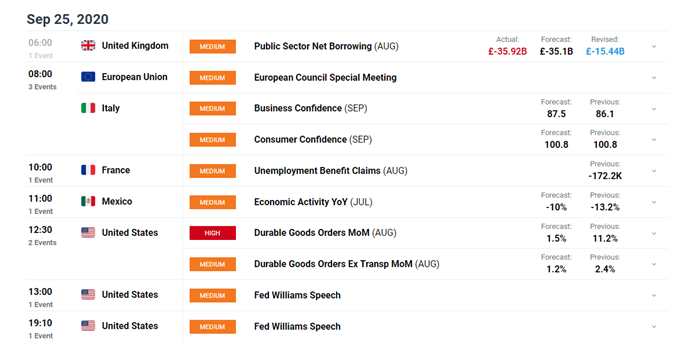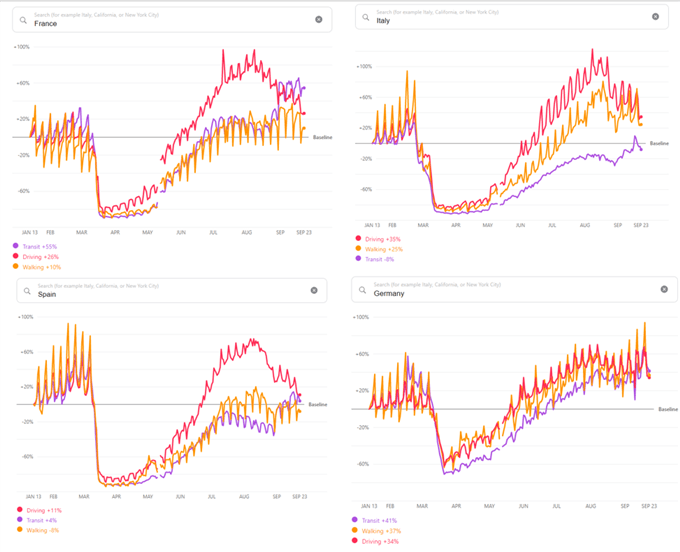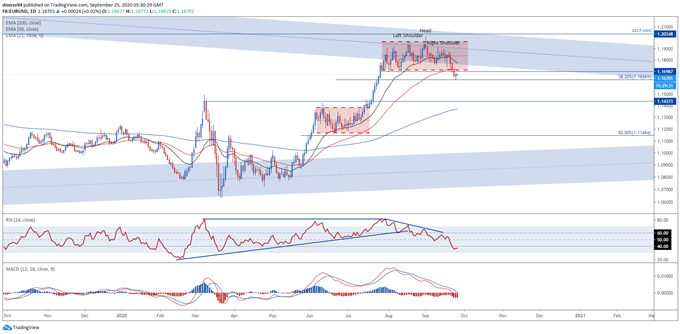EUR/USD, Covid-19 ‘Second Wave’, Italian-German Yield Spread, Mobility Data – Talking Points:
- A ‘second wave’ of Covid-19 infections in Europe has notably soured investors’ appetite for risk and may continue to hamper the performance of regional risk-sensitive assets.
- Widening Italian-German yield spread indicates a sustained period of risk-aversion could be in the making.
- EUR/USD rates appear poised to slide lower after breaking below the neckline of a bearish Head and Shoulders pattern.
Asia-Pacific Recap
Equities markets broadly gained during Asia-Pacific trade, as news that Democrats are drawing up a new $2.4 trillion stimulus bill to break the Congressional deadlock with Republicans notably buoyed risk appetite. Australia’s ASX 200 index surged 1.28% and Japan’s Nikkei 225 climbed 0.58%.
The haven-associated US Dollar and Japanese Yen lost ground against their major counterparts, as the risk-sensitive Australian Dollar crept marginally higher after recording 5-consecutive down-days for the first time since March.
Gold remained relatively unchanged along US 10-year Treasury yields, while silver slipped 0.2%.
Looking ahead, US durable goods orders for the month of August headline a rather light economic docket.

Covid-19 Second Wave Weighing on EUR/USD Rates
As mentioned in previous reports, the forced reimposition of coronavirus restrictions in several European nations is threatening to upend the Euro-area’s nascent economic recovery and may result in the continued discounting of regional risk-sensitive assets, if the worrying surge in Covid-19 cases prolongs.
With coronavirus infections in France surging by a record 16,096 on Thursday and hospitals filling up with seriously-ill Covid-19 patients in the Spanish capital of Madrid, there is a distinct possibility that economically devastating restrictions will be tightened in the near-term.
In fact, high-frequency data reflects a notable slowdown in all three mobility metrics – walking, driving and transit – across Germany, Spain, Italy and France, which suggests that local residents are pre-emptively scaling back their everyday activities in light of the Covid-19 “second wave”.
EU Mobility Trends (YTD)

Source – Apple Mobility Data
This marked reduction in overall mobility could stunt the progress of the Euro-zone’s economic recovery from the March doldrums and may continue to drag on market sentiment, given the IHS Markit Eurozone Composite PMI for September showed that the services sector recorded its largest contraction in output since May.
Moreover, the widening of the risk-gauging yield spread between Italian government bonds and German bunds seems to have coincided with not only the EUR/USD exchange rate’s recent spike lower, but also the marked increase in Covid-19 infections.
With that in mind, local coronavirus developments may dictate the short-term outlook for EUR/USD and could intensify the exchange rate’s 3-week slide from the yearly high set on September 1.
Italian-German Yield Spread vs EUR/USD (YTD)

Italian-German yield spread daily chart created using TradingView
EUR/USD Daily Chart – Head and Shoulder Neckline Break Hints at Further Downside
From a technical perspective, EUR/USD rates look poised to extend their slide lower after breaking below the neckline of a bearish Head and Shoulders reversal pattern and slicing through the trend-defining 50-day moving average (1.1715).
However, with the RSI swerving away from oversold territory and support at the 38.2% Fibonacci (1.1626) holding firm, a topside push could be in the offing.
That being said, inability to break back above the psychologically pivotal 1.17 level would probably validate the downside break of the Head and Shoulders pattern and could inspire a more sustained pullback, with the implied measured move suggesting price could slide back to the sentiment-defining 200-DMA (1.1375).
Conversely, a daily close back above the July 27 swing-low (1.1698) could encourage would-be buyers and potentially signal the resumption of the primary uptrend, with a breach of resistance at the 21-DMA (1.1774) bringing the yearly high (1.2011) into focus.

EUR/USD daily chart created using TradingView
-- Written by Daniel Moss, Analyst for DailyFX
Follow me on Twitter @DanielGMoss

